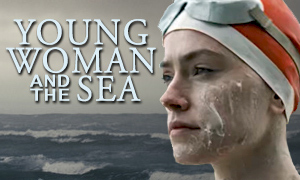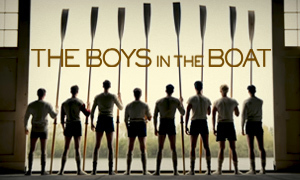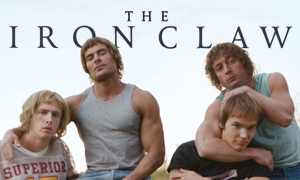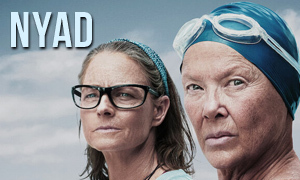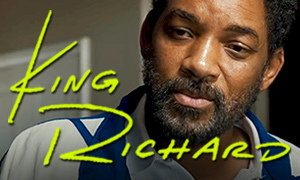Hands of Stone: History vs. Hollywood
| REEL FACE: | REAL FACE: |
Robert De Niro
Born: August 17, 1943 Birthplace: New York City, New York, USA | Ray Arcel
Born: August 30, 1899 Birthplace: Terre Haute, Indiana, USA Death: March 6, 1994, Manhattan, New York City, USA |
Edgar Ramírez
Born: March 25, 1977 Birthplace: Caracas, Venezuela | Roberto Duran
Born: June 16, 1951 Birthplace: El Chorrillo, Panama |
Usher Raymond
Born: October 14, 1978 Birthplace: Dallas, Texas, USA | Sugar Ray Leonard
Born: May 17, 1956 Birthplace: Wilmington, North Carolina, USA |
Ana de Armas
Born: April 30, 1988 Birthplace: Havana, Cuba | Felicidad Iglesias
Birthplace: Panama |
Jurnee Smollett-Bell
Born: October 1, 1986 Birthplace: New York City, New York, USA | Juanita Leonard
Born: 1957 Birthplace: Maryland, USA |
Ellen Barkin
Born: April 16, 1954 Birthplace: The Bronx, New York City, New York, USA | Stephanie Arcel
Born: December 9, 1918 Death: August 8, 2014, New York City, New York, USA |
John Turturro
Born: February 28, 1957 Birthplace: Brooklyn, New York City, New York, USA | Frankie Carbo
Born: August 10, 1904 Birthplace: Lower East Side, Manhattan, New York, USA Death: November 22, 1976, Miami Beach, Florida, USA |
Reg E. Cathey
Born: August 18, 1958 Birthplace: Huntsville, Alabama, USA | Don King
Born: August 20, 1931 Birthplace: Cleveland, Ohio, USA |
Rubén Blades
Born: July 16, 1948 Birthplace: Panama City, Panama | Carlos Eleta
Born: May 16, 1918 Birthplace: Panama City, Panama Death: January 16, 2013, Panama City, Panama |
Did Roberto Duran really grow up poor and starving?
Yes. In the movie, Roberto Duran (Edgar Ramírez) states, "I work all my life. I didn't have any food when I was a kid. I'm hungry. I don't want to be hungry anymore." The Hands of Stone true story reveals that the real Roberto Duran grew up in poverty in the slums of El Chorrillo in Panama City, Panama. He was born in a concrete apartment block known as La Casa de Piedra (the House of Stone). -Christian Giudice book
Did Roberto Duran really work in the streets as a boy to make money to help his mother?
Yes, in order to help his family eat, Duran worked in the streets when he was as young as five years old. While fact-checking Hands of Stone, we learned that he shined shoes for pennies and danced for coins, giving the money he earned to his mother. At age seven, he sold newspapers with his brother. Other jobs he did include painting and cleaning dishes in restaurants. -Christian Giudice book
How old was Roberto Duran when he started boxing?
Roberto Duran began sparring with experienced boxers when he was just eight years old at the Gimnasio Nacional (later renamed the Neco de La Guardia gymnasium). In 1968 at age 16, Duran made his professional boxing debut. -Biography.com
Did Roberto Duran really have a chip on his shoulder toward America?
Yes. In the film, when Roberto Duran (Edgar Ramírez) meets Ray Arcel (Robert De Niro) he expresses that he doesn't like anyone from America. Growing up in Panama, the real Roberto Duran harbored hostility towards America, the country that controlled the Canal Zone when the building of the Panama Canal was finished in 1914 (a project America had taken over in 1904). America's rights to the Zone region, which included both sides of the Canal, caused tensions. The Americans created a country club like atmosphere in the Zone and governed the area by U.S. law. It also didn't help that Roberto's father, Margarito Duran Sanchez, who had abandoned him when he was just a year and five months old, was an American. Margarito was a U.S. Army cook of Mexican decent from Arizona who had been stationed in the Canal Zone. He left abruptly when his tour of duty ended. -Christian Giudice book
How old were Roberto Duran and his wife when they got married?
Some reports claim that Roberto Duran married his wife Felicidad Iglesias near the start of his professional boxing career when he was 17 and she was only 14 (The Portland Press Herald). However, it is not uncommon in the impoverished areas of Panama for two people to call each other husband and wife long before ever having an official ceremony. Christian Giudice's book Hands of Stone, on which the movie was based, puts the wedding sometime shortly after Duran's 1980 victory against Leonard, when Felicidad's parents finally approved of him. Duran and Felicidad are the parents of eight children. In researching the Hands of Stone true story, we learned that Roberto Duran had another child, a daughter named Dalia. Her mother was Silvia, a girlfriend who he was involved with while dating Felicidad.
Did Ray Arcel leave boxing because of pressure from the mob?
Yes. Like in the movie, Arcel was pressured out of the business by the Mob, who didn't like his idea of securing television deals to take boxing national. In 1953, a then 54-year-old Arcel was standing outside a Boston hotel when a man emerged from a crowd and hit him in the back of the head with a piece of pipe wrapped in a paper bag. Arcel nearly died and was laid up in the hospital for 19 days. The assault was a major influence on his decision to retire from the sport in 1956 and work in the purchasing department of an alloy company. He wouldn't return to boxing for roughly 16 years. In 1972, Roberto Duran's manager, Carlos Eleta, asked a 72-year-old Arcel to train one of his fighters, Alfonso "Peppermint" Frazer, who was set to fight for the championship of the world. After Frazer won, Eleta asked Arcel to watch Duran fight. View a Ray Arcel interview during which he reflects on his career and the fighters he worked with. -Christian Giudice book
Did trainer Ray Arcel really comb Roberto Duran's hair in between rounds?
In the Hands of Stone movie, Ray Arcel (Robert De Niro) combs Roberto Duran's hair back in between rounds. When Duran (Edgar Ramírez) asks Arcel why he does this, Arcel responds, "Next round starts you come out lookin' fresh. Drives 'em nuts." It's believable that Arcel did this, as he had a penchant for clean living and a clean appearance (he always wore ties), but it doesn't appear in Christian Giudice's Hands of Stone book or in Donald Dewey's Ray Arcel biography. Also, in watching the first fight against Sugar Ray Leonard, Ray Arcel never combs Roberto Duran's hair back in between rounds (he only wipes the sweat from Duran's face). In the movie, De Niro's character uses it as a way to help psych out Duran's opponents, but it doesn't seem to have happened in real life.
Did Roberto Duran really name his son Robin after Robin Hood?
Yes. As soon as Roberto Duran became successful as a boxer, he gave a large portion of his earnings back to his community in Panama and was even known to hand out money in the streets. "He told me once, 'I like to be like Robin Hood. If I have money, I will give the poor people all the money.' And he did," said his first manager Carlos Eleta. He even named his son Robin after the English folklore hero who robs from the rich and gives to the poor. -Beyond the Glory
Did Roberto Duran really insult Sugar Ray Leonard's wife?
Yes. The encounter was real. Leonard at first offered Duran a smile when he saw his next opponent coming towards him and his wife, but Duran had other things in mind. "He taunted me," Leonard later told the Los Angeles Times. "He cursed my mother, my children, my wife. He said unbelievable things and I let them get to me." According to Leonard's trainer Angelo Dundee, Duran told Leonard's wife Juanita that he was going to kill her husband. "That got to Ray," says Dundee. "He couldn't believe that Duran could be so crude in front of his wife. He was a family man and a father." To Duran, the U.S. Olympic champion Leonard represented silver spoon American privilege, a fighter whose toughness was nothing more than a facade created by the media. -Christian Giudice book
Had Sugar Ray Leonard really been undefeated when he first faced Roberto Duran?
Yes. During our exploration into the Hands of Stone true story, we confirmed that up until Sugar Ray Leonard's first fight with Roberto Duran, known as the "Brawl in Montreal," he had been undefeated. After beating Leonard by unanimous decision, Roberto Duran became the WBC welterweight champion of the world. -Biography.com
How much did Roberto Duran and Sugar Ray Leonard each earn for "The Brawl in Montreal"?
In fact-checking the Hands of Stone movie, we learned that Roberto Duran received $1.65 million for the June 20, 1980 fight and Sugar Ray Leonard took home nearly $8.5 million, making him the highest-paid boxer in history at the time. Feeling that his take was unfair, Duran made sure to be compensated better for their second fight, especially after emerging victorious in the first. For the November 25, 1980 rematch, Duran received $8 million and Leonard got $7 million. -Christian Giudice book
Had Roberto Duran been undefeated prior to losing against Sugar Ray Leonard in their rematch?
No. After 31 straight victories, Roberto Duran lost his first fight in a non-title light welterweight bout against Esteban De Jesús in 1972. Following the loss, he amassed 41 consecutive wins and defeated De Jesús in 1978 to claim the WBC lightweight title. In 1979, Duran relinquished his belts to move up to the welterweight class, and on June 20, 1980, he sought to capture the WBC welterweight title from a then undefeated Sugar Ray Leonard. Duran won the fight by unanimous decision after 15 rounds. His record then stood at 72-1 with 55 knockouts. -Biography.com
Did greed really drive Roberto's manager to arrange for him to fight Sugar Ray again just five months later?
Greed did play a part but was not the whole reason that Roberto's manager Carlos Eleta rushed the rematch. As depicted in the movie, Eleta arranged a second fight with Sugar Ray Leonard to take place on November 25, 1980, just five months after Roberto Duran had beat him. The fight was being promoted by Don King and would land Eleta with an $8 million score. Eleta claimed that he hurried the fight because Duran began drinking and putting on weight. He felt that Duran would soon not even beat a second-rate fighter. -Christian Giudice book
Was Roberto prepared to take on Sugar Ray again so soon?
No. After defeating Sugar Ray Leonard and becoming the welterweight champion of the world, Roberto Duran spent months partying and celebrating his victory. Like in the movie, he had gained roughly 40 pounds (though Duran has claimed it was more), which he then needed to lose in order to fight. He stepped into the boxing ring in New Orleans Superdome ill-prepared for the rematch, both physically and mentally. As champion, he had lost his burning desire to win. -Christian Giudice book
Why did Roberto Duran abruptly stop his second fight against Sugar Ray Leonard?
Roberto Duran quit the fight in the eighth round, telling his trainer and corner men, "I will not fight with this clown anymore." As seen in the Sugar Ray Leonard Roberto Duran fight video, Leonard taunted Duran and at times made him look foolish. Duran would later tell the press that stomach pain forced him to stop, but he was irritated by Leonard's lack of respect. -The Portland Press Herald
Did Roberto Duran ever utter the words, "No mas"?
No. The Hands of Stone true story confirms that Roberto Duran never actually said, "No mas." Duran himself says that he never used those words. According to manager Carlos Eleta, Duran said, "I will not fight with this clown anymore." Howard Cosell, who was broadcasting the fight, picked up only the words "no mas" (no more), which have become cemented in sports history. "No mas" also made for better headlines. -Christian Giudice book
Did Roberto Duran attempt a comeback after quitting the "No Mas" fight against Sugar Ray Leonard?
Yes, but consecutive losses fueled speculation that his career as a boxer had reached its end. Promoter Don King dropped him. His manager Carlos Eleta and the rest of his corner cut ties with him as well. He had become a punchline in the world of boxing. However, the fire that once burned in him slowly began to ignite again, and at age 33 he found himself going up against Davey Moore, the then undefeated junior middleweight champion. No one believed Duran could win, but he did with a knockout, securing his third world championship. He boxed for nearly two more decades, moving up another weight class (middleweight) and winning a fourth world championship on February 24, 1989 against Iran Barkley. Duran suffered broken ribs and a punctured lung in a 2001 car accident, prompting him to officially retire from boxing in 2002 when he was 50. -Beyond the Glory
Where did the movie's title "Hands of Stone" come from?
The title is based on Roberto Duran's nickname, "Manos de Piedra" ("Hands of Stone"), which alludes to his power as a bruiser in the ring. The nickname was coined by Panamanian boxing writer/broadcaster Alfonso Castillo, who came up with it after watching Duran pulverize Benny Huertas in 1971, winning by TKO in the first round. -Christian Giudice book
Did Roberto Duran ever fight Sugar Ray Leonard again after quitting the "No Mas" fight?
Yes. Nearly a decade after the "No Mas" fight, Roberto Duran got his rematch against Sugar Ray Leonard in December of 1989. Both fighters were past their prime and Leonard won the third fight substantially by unanimous decision.
Was Roberto Duran Ray Arcel's favorite among the champions he trained?
No. According to Ray's wife, Stephanie Arcel, of the 22 champions her husband trained, his favorite was Benny Leonard, a lightweight boxer who became champion during World War I. "He was a master fighter," Stephanie said of Benny, "and Ray liked brains over brawn." -The New York Times
What is Roberto Duran doing today?
Roberto Duran lives in his home country of Panama where he owns a restaurant. -The Portland Press Herald
Ray Arcel Interview & Roberto Duran Fight Videos
Watch the first Roberto Duran vs. Sugar Ray Leonard fight in its entirety, then watch Duran and Leonard being interviewed about the fight. Strengthen your knowledge of the Hands of Stone true story by watching a Ray Arcel interview and a video that highlights the infamous rematch between Roberto Duran and Sugar Ray Leonard, which Duran quit in the eighth round.
Link-to-Learn More:
